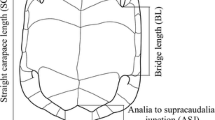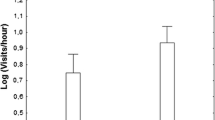Abstract
The costs of reproduction are widely recognised as a major selective force in the evolution of various behavioural and life-history characteristics. In particular, the behaviour of reproductively active animals is likely to change when breeding increases risk of predation. We investigated the effect of an experimentally derived threat on the vigilance and escape behaviour of female Trichosurus caninus with and without dependent offspring and at different stages of offspring development. Females with offspring showed a heightened response to the threat in comparison to females without offspring. In addition, females with offspring displayed a stronger response at earlier stages of their offspring’s development.



Similar content being viewed by others
References
Ackerman JT, Eadie JM (2003) Current versus future reproduction: an experimental test of parental investment decisions using nest desertion by mallards (Anas platyrhynchos). Behav Ecol Sociobiol 54:264–273
Altmann S (1980) Baboon mothers and infants. Harvard University Press, Cambridge, Mass.
Bakker HR, Main AR (1980) Condition, body composition and total body water estimation in the Quokka, Setonix brachyurus (Macropodidae). Aust J Zool 28:395–406
Barrett L, Dunbar RIM, Dunbar F (1995) Mother–infant contact as contingent behaviour in gelada baboons. Anim Behav 49:805–810
Bauwens D, Thoen C (1981) Escape tactics and vulnerability to predation associated with reproduction in the lizard Lacerta vivipara. J Anim Ecol 50:733–743
Berger J (1991) Pregnancy incentives, predation constraints and habitat shifts: experimental and field evidence for wild bighorn sheep. Anim Behav 41:61–77
Brodie ED III (1989) Behavioural modification as a means of reducing the cost of reproduction. Am Nat 143:225–238
Buitron D (1983) Variability in the responses of black-billed magpies to natural predators. Behaviour 87:209–236
Cassinello J (1997) Mother–offspring conflict in the Saharn Arrui, Ammotragus lervia sahariensis: relationship to weaning and mother’s sexual activity. Ethology 103:127–137
Clark CB (1977) A preliminary report on weaning among chimpanzees of the Gombe National Park. In: Chevalier-Skolnikoff S, Poirier FE (eds) Primate bio-social development: biological, social and ecological determinants. Garland, New York, pp 235–260
Clarke J, Loudon ASI (1985) The effect of differences in herbage height on the grazing behaviour of lactating Bennett’s wallabies (Macropus rufogriseus rufogriseus). J Zool (Lond) 207:537–544
Clutton-Brock TH, Godfray HCJ (1991) Parental investment. In: Krebs JR, Davies NB (eds) Behavioural ecology: an evolutionary approach. Blackwell, Oxford, pp 234–262
Cork SJ, Dove H (1989) Lactation in the tammar wallaby (Macropus eugenii). II. Intake of milk components and maternal allocation of energy. J Zool (Lond) 219:399–409
Fisher DO, Goldizen AW (2001) Maternal care and infant behaviour of the bridled nailtail wallaby. J Zool (Lond) 255:321–330
Hauser MD (1988) Variation in Maternal responsiveness in free-ranging vervet monkeys: a response to infant mortality risk. Am Nat 131:573–587
Hinds LA, Janssens PA (1986) Changes in prolactin in peripheral plasma during lactation in the brushtail possum Trichosurus vulpecula. Aust J Biol Sci 39:43–57
How RA (1978) Population strategies of four species of Australian ‘possums’. In: Montgomery GG (ed) The ecology of arboreal folivores. Smithsonian Institute Press, Washington, D.C., pp 305–313
How RA (1981) Population parameters of two congeneric possums, Trichosurus spp., in north-eastern New South Wales. Aust J Zool 29:205–215
How RA (1995) Mountain brushtail possum. In: Strahan R (ed) The mammals of Australia. Reed Books, Chatswood, New South Wales, pp 271–272
Klemola T, Korpimaki E, Norrdahl K (1998) Does avian predation risk depress reproduction of voles. Oecologia 115:149–153
Lack D (1947) The significance of clutch size. 1. Intraspecific variation. Ibis 89:302–352
Lack D (1954) The natural regulation of animal numbers. Oxford University Press, Oxford
Lima SL, Dill LM (1990) Behavioural decisions made under the risk of predation: a review and prospectus. Can J Zool 68:619–640
Lindenmayer DB, Welsh A, Donnelly CF, Meggs RA (1996) Use of nest trees by the mountain brushtail possum (Trichosurus caninus) (Phalangeridae: Marsupialia). I. Number of occupied trees and frequency of tree use. Wildl Res 23:343–361
Loudon ASI (1987) The reproductive energetics of lactation in a seasonal macropodid marsupial: comparison of marsupial and eutherian herbivores. Zool Symp 57:419–439
Macwhirter RB (1991) Effects of reproduction on activity and foraging behaviour of adult female Columbian ground squirrels. Can J Zool 69:2009–2216
Magnhagen C (1991). Predation risk as a cost of reproduction. Trends Ecol Evol 6:183–185
Martin R, Handasyde K (1999) The koala: natural history, conservation and management. UNSW Press, Kensington, New South Wales
Maynard Smith J (1977) Parental investment: a prospective analysis. Anim Behav 25:1–9
Nicolson NA (1987) Infants, mothers and other families. In: Smuts BB, Cheney DL, Seyfarth RM, Wrangham RW, Struhsaker TT (eds) Primates societies. Chicago University Press, Chicago, pp 330–342
Patterson TL, Petrinovich L, James DK (1980) Reproductive value and appropriateness of response to predators by white-crowned sparrows. Behav Ecol Sociobiol 7:227–231
Qualls CP, Shine R (1998) Costs of reproduction in conspecific oviparous and viviparous lizards, Lerista bougainvillii. Oikos 82:539–551
Quinn GP, Keough MJ (2002) Experimental design and data analysis for biologists. Cambridge University Press, Cambridge
Rachlow JL, Bowyer RT (1998) Habitat selection by Dall’s sheep (Ovis dalli): maternal trade-offs. J Zool (Lond) 245:457–465
Redondo T, Carranza J (1989) Offspring reproductive value and nest defence in the magpie (Pica pica). Behav Ecol Sociobiol 25:369–378
Ruckstuhl KE, Festa-Bianchet M (1998) Do reproductive status and lamb gender affect the foraging behaviour of bighorn ewes? Ethology 104:941–954
Russell EM (1982) Patterns of parental care and parental investment in marsupials. Biol Rev 57:423–486
Schwarzkopf L, Shine R (1992) Costs of reproduction in lizards: escape tactics and susceptibility to predation. Behav Ecol Sociobiol 31:17–25
Shaffer LR, Formanowicz DR (1996) A cost of viviparity and parental care in scorpions: reduced sprint speed and behavioural compensation. Anim Behav 51:1017–1024
Shine R (1980) “Costs” of reproduction in reptiles. Oecologia 46:92–100
Stearns SC (1976) Life-history tactics: a review of the ideas. Q Rev Biol 51:3–47
Stearns SC (1992) The evolution of life histories. Oxford University Press, Oxford
Swaisgood RR, Owings DH, Rowe MP (1999) Conflict and assessment in a predator–prey system: ground squirrels versus rattlesnakes. Anim Behav 57:1033–1044
Swaisgood RR, Rowe MP, Owings DH (2003) Antipredator responses of Californian ground squirrels to rattlesnakes and rattling sounds: effects of sex, parity, and offspring characteristics on assessment and decision-making rules. Behav Ecol Sociobiol 55:22–31
Treves A, Drescher A, Snowdon CT (2003) Maternal watchfulness in black howler monkeys (Alouatta pigra). Ethology 109:135–146
Trivers RL (1974) Parent–offspring conflict. Am Zool 14:249–264
Williams GC (1966) Natural selection, the costs of reproduction, and a refinement of Lack’s principle. Am Nat 100:687–690
Winter JW (1980) Tooth wear as an age index in a population of the brush-tailed possum, Trichosurus vulpecula (Kerr). Aust Wildl Res 7:359–363
Wright C (2000) Foraging behaviour and diet of mountain brushtail possums, Trichosurus caninus, in remnant patches. Victoria Hons thesis, University of Melbourne, Victoria
Acknowledgements
We thank Blair Patullo, Dave Semmens, Claire Maries, Andrew Vance, Simon Hart and especially Roger Martin for their help in the field. We thank Noel Osbourne for allowing us access to his property, and the Lobert family for their kind hospitality. We also thank Dave Forsyth and Graeme Coulson for their helpful advice and comments on earlier drafts of this manuscript. This research was conducted with the permission of the Department of Natural Resources and Environment (permit no. 10000466) and the University of Melbourne AEEC (registration no. 99010).
Author information
Authors and Affiliations
Corresponding author
Additional information
Communicated by P. Bednekoff
Rights and permissions
About this article
Cite this article
McDonald-Madden, E., Elgar, M.A. & Handasyde, K.A. Responses to threat by female bobucks, Trichosurus caninus, during different stages of offspring development. Behav Ecol Sociobiol 56, 322–327 (2004). https://doi.org/10.1007/s00265-004-0799-0
Received:
Revised:
Accepted:
Published:
Issue Date:
DOI: https://doi.org/10.1007/s00265-004-0799-0




